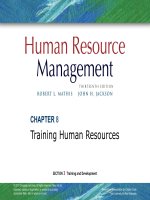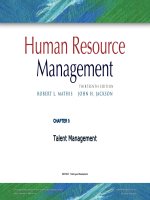Human resrouce management 13th mathis jacson chapter 07
Bạn đang xem bản rút gọn của tài liệu. Xem và tải ngay bản đầy đủ của tài liệu tại đây (1.86 MB, 44 trang )
CHAPTER 7
Selecting Human Resources
SECTION 2 Jobs and Labor
©
© 2011
2011 Cengage
Cengage Learning.
Learning. All
All rights
rights reserved.
reserved. May
May not
not be
be scanned,
scanned, copied
copied or
or duplicated,
duplicated, or
or posted
posted to
to aa
publicly
publicly accessible
accessible Web
Web site,
site, in
in whole
whole or
or in
in part.
part.
PowerPoint
PowerPoint Presentation
Presentation by
by Charlie
Charlie Cook
Cook
The
The University
University of
of West
West Alabama
Alabama
Chapter Objectives
After you have read this chapter, you should be able to:
•
Summarize the importance of realistic job previews and application screening efforts to the selection process.
•
Diagram the sequence of a typical selection process.
•
Discuss how validity and reliability are related to selection.
•
Identify three types of selection tests and legal concerns about their uses.
•
Contrast several types of selection interviews and some key considerations in conducting these interviews.
•
Specify how legal concerns affect background investigations of applicants and use of medical examinations in the
selection process.
•
Describe the major issues to be considered when selecting candidates for global assignments.
© 2011 Cengage Learning. All rights reserved. May not be scanned, copied or duplicated, or posted to a publicly accessible Web
site, in whole or in part.
7–2
Selection and Placement
• Selection
The process of choosing individuals with qualifications needed to fill jobs in an organization.
Organizations need qualified employees to succeed.
“Hire hard, manage easy.”
“Good training will not make up for bad selection.”
• Placement
Fitting a person to the right job.
© 2011 Cengage Learning. All rights reserved. May not be scanned, copied or duplicated, or posted to a publicly accessible Web
site, in whole or in part.
7–3
Applicant Knowledge, Skills, and Abilities
• Person-Job Fit
Matching the knowledge, skills and abilities (KSAs) of people to the characteristics of jobs
(tasks, duties and responsibilities–TDRs).
Benefits of person-job fit:
Higher employee performance
Lower turnover and absenteeism
• Person-Organization Fit
The congruence between individuals and organizational factors.
KSAs = TDRs = Job Success?
© 2011 Cengage Learning. All rights reserved. May not be scanned, copied or duplicated, or posted to a publicly accessible Web
site, in whole or in part.
7–4
Person/Job Fit Mismatches
Geography/
Skills/job qualifications
job location
Mismatch
Situations
Earnings/
Time/amount of work
expectations
Work/family
© 2011 Cengage Learning. All rights reserved. May not be scanned, copied or duplicated, or posted to a publicly accessible Web
site, in whole or in part.
7–5
Criteria, Predictors, and Job Performance
•
Selection Criterion
•
Predictors of Selection Criteria
•
Measurable or visible indicators of selection criteria.
Validity
•
A characteristic that a person must have to successfully perform work.
The correlation between a predictor and job performance.
Reliability
The extent to which a predictor repeatedly produces the same results over time.
© 2011 Cengage Learning. All rights reserved. May not be scanned, copied or duplicated, or posted to a publicly accessible Web
site, in whole or in part.
7–6
Validity
• Correlation Coefficient
Is an index number that gives the relationship between a predictor variable and a criterion
variable.
• Concurrent Validity
Is measured when an employer tests current employees and correlates the scores with their
performance ratings.
• Predictive Validity
Measured when test results of applicants are compared with subsequent job performance.
© 2011 Cengage Learning. All rights reserved. May not be scanned, copied or duplicated, or posted to a publicly accessible Web
site, in whole or in part.
7–7
FIGURE 7–1
Job Performance, Selection Criteria,
and Predictors
© 2011 Cengage Learning. All rights reserved. May not be scanned, copied or duplicated, or posted to a publicly accessible Web
site, in whole or in part.
7–8
FIGURE 7–2
Concurrent
and Predictive
Validity
© 2011 Cengage Learning. All rights reserved. May not be scanned, copied or duplicated, or posted to a publicly accessible Web
site, in whole or in part.
7–9
Combining Predictors
• Multiple Hurdles
Establishing a minimum cutoff (level of performance) for each predictor, and requiring that
each applicant must score at least the minimum on each predictor to be considered for
hiring.
• Compensatory Approach
Scores on all predictors are added together, allowing a higher score on one predictor to
offset a lower score on another predictor.
© 2011 Cengage Learning. All rights reserved. May not be scanned, copied or duplicated, or posted to a publicly accessible Web
site, in whole or in part.
7–10
FIGURE 7–3
Typical Division of HR Responsibilities: Selection
© 2011 Cengage Learning. All rights reserved. May not be scanned, copied or duplicated, or posted to a publicly accessible Web
site, in whole or in part.
7–11
HR Employment Functions
1.
2.
3.
4.
5.
6.
7.
8.
9.
Receiving applications
Interviewing applicants
Administering tests to applicants
Conducting background investigations
Arranging physical examinations
Placing and assigning new employees
Coordinating follow-up of new employees
Exit interviewing departing employees
Maintaining employee records and reports
© 2011 Cengage Learning. All rights reserved. May not be scanned, copied or duplicated, or posted to a publicly accessible Web
site, in whole or in part.
7–12
FIGURE 7–4
Selection Process Flowchart
© 2011 Cengage Learning. All rights reserved. May not be scanned, copied or duplicated, or posted to a publicly accessible Web
site, in whole or in part.
7–13
Applicant Job Interest
• Realistic Job Preview
The process through which a job applicant receives an accurate picture of the job.
Prevents the development of unrealistic job expectations in new employees.
Helps avoid truth-in-hiring lawsuits
© 2011 Cengage Learning. All rights reserved. May not be scanned, copied or duplicated, or posted to a publicly accessible Web
site, in whole or in part.
7–14
Pre-Employment Screening
• Electronic Assessment
Screening
There is a large volume
of applicants
Quality of hires needs
to be increased
When To Use Electronic
Hiring cycles need
Screening
to be shortened
The cost of hiring needs
to be reduced
There is a need to reach unvisited geographic areas
© 2011 Cengage Learning. All rights reserved. May not be scanned, copied or duplicated, or posted to a publicly accessible Web
site, in whole or in part.
7–15
Application Disclaimers and Notices
Employment-At-Will
References Contacts
Application
Employment Testing
Form
Application Time Limit
Information Falsification
© 2011 Cengage Learning. All rights reserved. May not be scanned, copied or duplicated, or posted to a publicly accessible Web
site, in whole or in part.
7–16
Applications
• Purposes of Applications
Record of applicant’s desire for the job
Provides a profile of the applicant
Basic record for applicants hired
Research effectiveness of the selection process
• Resumes as Applications
Resumes are applications for EEO purposes.
Resumes should be checked for truthfullness.
© 2011 Cengage Learning. All rights reserved. May not be scanned, copied or duplicated, or posted to a publicly accessible Web
site, in whole or in part.
7–17
FIGURE 7–5
Sample Application Form
© 2011 Cengage Learning. All rights reserved. May not be scanned, copied or duplicated, or posted to a publicly accessible Web
site, in whole or in part.
7–18
EEO Considerations and Application Forms
• Applications should not contain illegal (nonjob-related) questions concerning:
Marital status
Height/weight
Number and ages of dependents
Information on spouse
Date of high school graduation
Contact in case of emergency
© 2011 Cengage Learning. All rights reserved. May not be scanned, copied or duplicated, or posted to a publicly accessible Web
site, in whole or in part.
7–19
Acceptable Documents
for Verifying Eligibility to
Work in the United
States
© 2011 Cengage Learning. All rights reserved. May not be scanned, copied or duplicated, or posted to a publicly accessible Web
site, in whole or in part.
7–20
Selection Testing: Ability Tests
Cognitive Ability
Tests
Physical Ability
Psychomotor
Tests
Tests
Ability Tests
Aptitude and Achievement
Work Sample
Situational Judgment Tests
Tests
Assessment
Centers
© 2011 Cengage Learning. All rights reserved. May not be scanned, copied or duplicated, or posted to a publicly accessible Web
site, in whole or in part.
7–21
Other Tests
• Personality Tests
Minnesota Multiphasic Personality Inventory (MMPI)
Myers-Briggs
“Fakability” and personality tests
• Honest/Integrity Tests
Socially desirable responses
False positives
Polygraph tests (“lie detector”)
The Employee Polygraph Protection Act prohibits pre-employment testing (in most
instances).
© 2011 Cengage Learning. All rights reserved. May not be scanned, copied or duplicated, or posted to a publicly accessible Web
site, in whole or in part.
7–22
FIGURE 7–6
Big Five Personality Characteristics
© 2011 Cengage Learning. All rights reserved. May not be scanned, copied or duplicated, or posted to a publicly accessible Web
site, in whole or in part.
7–23
Controversies in Selection Testing
• General Mental Ability Testing
Minority groups tend to score lower on tests
Requires business necessity defense and validation.
• Personality Testing
Explains very little about actual job outcomes.
© 2011 Cengage Learning. All rights reserved. May not be scanned, copied or duplicated, or posted to a publicly accessible Web
site, in whole or in part.
7–24
Selection Interviewing
• Interviewing for Selection
Gathering valid information
Focusing on ways to minimize selection errors
Initial screening
Assessing the qualifications
In-depth selection
interview
of applicants
interview
© 2011 Cengage Learning. All rights reserved. May not be scanned, copied or duplicated, or posted to a publicly accessible Web
site, in whole or in part.
7–25









